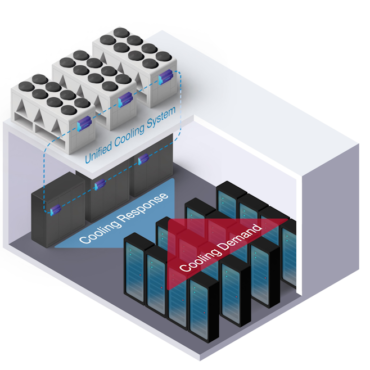The commercial HVAC industry will experience substantial changes in 2025 and 2026, driven by technological advancements, workforce challenges, and shifting market demands. Commercial contractors are working with new HVAC technology, trying to meet mandatory refrigerant changes, and taking steps to overcome a nationwide HVAC technician labor shortage.
Increased Installation of All-Climate VRF Systems
According to the U.S. Department of Energy (DOE), buildings consume 75% of the nation’s electricity. Energy is an enormous annual expense for building operators, but thankfully, it is a cost that can be reduced using the right technology.
With more performance mandates in play, building owners and operators are increasingly moving toward more cost-effective, high-performance heating and cooling solutions like all-climate variable refrigerant flow (VRF) technology. The benefits of outfitting buildings with all-climate VRF solutions, the fastest growing segment of the commercial HVAC industry, are numerous, but at the top of the list is their highly efficient operation, lower overall cost, and enhanced comfort.
Unlike conventional systems that cycle on and off, a VRF solution can operate continuously at partial load, resulting in higher overall operating efficiency. These systems are efficient because they are designed to provide the precise amount of cooling or heating needed in a space.
VRF systems use the least amount of energy needed to maintain each zone’s set point, potentially helping to reduce utility bills. As conditioning demands fluctuate with occupancy, activities, and outdoor temperatures, the VRF system ramps up and down as needed to keep indoor temperatures steady.
More compact than conventional equipment, VRF systems can also reduce upfront costs by requiring less structural support, easier installation access, and fewer alterations to building facades. This smaller footprint, combined with the diverse selection of ductless and ducted indoor units, gives owners, architects, and engineers design flexibility to meet aesthetic and application requirements.
Refrigerant Changes Underway
Regulatory shifts will impact commercial refrigerants. Specifically, the American Innovation and Manufacturing (AIM) Act requires that all new commercial refrigeration equipment must use refrigerants with a low Global Warming Potential (GWP) by Jan. 1, 2026. This transition to low-GWP refrigerants aims to provide a lower environmental impact on building operations. While redesigning around new refrigerants, VRF manufacturers will also improve equipment efficiency, yielding a more efficient and effective heating and cooling solution. The most likely candidates to replace traditional refrigerants like R-410A are A2L refrigerants, such as R-454B and R-32. These A2L refrigerants offer a significantly lower GWP, making them a more environmentally friendly option.
In addition to using new refrigerant, expect the industry to start using newer technologies in VRF systems that use less refrigerant and increase efficiency compared with current VRF solutions. The efficiency gains will play a key role in optimizing energy use.
Weber State University in Ogden, Utah, is a great example. Today, many of its buildings have been retrofitted with all-electric, all-climate, water-source heat pump solutions. Moving forward, the university plans to convert the entire campus to Mitsubishi Electric Hybrid VRF solutions. Hybrid VRF systems use water instead of refrigerant indoors, providing efficient heating and cooling performance and future-proof sustainability.
Workforce Development & Succession Planning Gaining Ground
Meeting the growing demand for all-climate heat pump solutions will require a major focus on education and training for HVAC contractors to ensure they have the skills to install and service these systems effectively. To that end, the most forward-thinking and successful commercial HVAC business owners are prioritizing up-to-date training, often in collaboration with their suppliers. Organizations like Mitsubishi Electric Trane HVAC US (METUS) have expanded their contractor training efforts in recent years to help meet this need.
That is not the only challenge HVAC businesses will face this year. Many HVAC companies face staffing challenges. McKinsey reports that the decline in skilled workers stems from too few people entering skilled trades. Recruiting and retaining HVAC contractors remains an issue, even for companies whose all-climate heat pump business is thriving.
HVAC companies will increasingly focus on succession planning to help bridge the gap. Knowledge transfer, mentorship programs, and leadership development for the next generation will be essential for ensuring business continuity and preparing the next generation of HVAC professionals.
Therefore, many existing HVAC businesses are looking to their children to enter – and someday – take over the business, while others are actively recruiting cohorts of Generation Z. For example, Brenda Harmon, who co-owns Tri-Tech Heating & Cooling with her husband, has three Generation Z sons who grew up working in the business. The couple hopes their boys will one day take over the Vancouver, Wash., HVAC company.
“Our twins, Jason and Zach, and their younger brother, Matthew, have grown up in the business, and we are thankful that our Gen Zers participate in the trade and are working hard to take over when we retire in the next few years,” she said.
Becoming an HVAC technician today means having a stable, profitable job in a necessary, in-demand, growing, and evolving industry.
Know Current Trends for Greater Likelihood of Success
Keeping up with today’s commercial HVAC trends helps HVAC business owners and technicians thrive in an evolving industry. Staying on top of advancements and changes, whether innovative all-climate heat pump technology, refrigerant changes, or ways to navigate the labor shortage, is the best way to stay competitive and grow their HVAC businesses.
Whether you require installation, repair, or maintenance, our technicians will assist you with top-quality service at any time of the day or night. Take comfort in knowing your indoor air quality is the best it can be with MOE heating & cooling services Ontario's solution for heating, air conditioning, and ventilation that’s cooler than the rest.
Contact us to schedule a visit. Our qualified team of technicians, are always ready to help you and guide you for heating and cooling issues. Weather you want to replace an old furnace or install a brand new air conditioner, we are here to help you. Our main office is at Kitchener but we can service most of Ontario's cities
Source link


